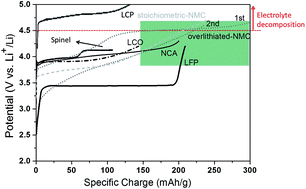Enhancement of the high potential specific charge in layered electrode materials for lithium-ion batteries
Abstract
Among the layered transition metal oxide electrodes, the NCA (Li(Ni1−x−yCoxAly)O2) and the NMC (Li1+a(NixMnyCoz)1−aO2) families with working potentials ranging from 4 V to close to 5 V against Li metal are nowadays identified as potential high specific energy materials. The present candidates have their advantages and drawbacks, i.e. NCA is a high energy density material but safety is of major concern while NMC has a lower energy density but exhibits improved safety. Recently, overlithiated layered transition metal oxides have proved to deliver reversible specific charge over 200 mA h g−1. The high specific charge is associated with a complex reaction mechanism that involves the activation of the material at high potentials. However, further R&D is needed for the current technology to meet the needs, in terms of safety, cost, energy and power capabilities, of the emerging HEV and EV market. A review of the state-of-the-art of these families of compounds together with current approaches for their future development is presented.


 Please wait while we load your content...
Please wait while we load your content...